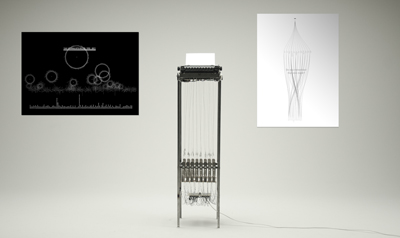Julian Koschwitz is doing his part to ensure that the 918 journalists killed for their work since 1992 don’t fade into mere numbers.
Koschwitz, an interactive art director who teaches at the Free University of Bozen-Bolzano in northern Italy, creates installations that connect virtual media to practical mechanical devices. His most recent work, “On Journalism #2 Typewriter,” writes stories about individual journalists who have been killed worldwide since 1992. The text, which is continually typed, uses data about the journalists’ lives as well as their published work. Individual stories are connected through common subjects such as the field of coverage and location. The typewriter also creates images with varying levels of distortion depending on how many journalists have been killed in a particular country.
The installation’s data is based on the CPJ website and supplemented with information about the journalists and their work found through Web searches. Because the typewriter runs on generative software, using queries on different websites to create each person’s story, Koschwitz estimates that it would take four to five months before any information is repeated.
“I want to provide something very known and familiar and to augment it in a way you wouldn’t expect, so we get into a field where we interact in a meta-level, where we try to understand more the story behind it, the technological history and human history behind the object,” Koschwitz says.
By using a typewriter, an outdated machine, the artist examines the space between the work that journalists produce and the way we have become accustomed to receiving that work. The installation not only highlights our relationship to media and technology, but also illustrates the disconnect between the information we receive, often virtually, and the people who risk their lives to provide it. “Today, with all the media we’re surrounded by, maybe we don’t think about who actually risks their life to provide the information,” he says. “I felt this is something that needs to be remembered and put in our consciences.”
Koschwitz says he is intrigued by the idea of taking information from a database and coming up with new categories in order to use the data to tell stories. “I can use a database, which you wouldn’t consider using as storytelling, to unfold and tell a story from it and give a touch to a story that can take different paths and can have a different angle,” he says. This creates the opportunity to contextualize, in this case not just how many journalists have been killed, but from where, what they were reporting on, and how the topic they reported on years ago is still being written about today.
By combining virtual data with something tangible that we recognize from our daily lives, Koschwitz wants us to question our behavior toward a particular object. He once created a faucet that, when turned on, triggered the expected sound of running water, but had no water actually coming out of the faucet. This piece was intended to provoke ideas about water use, availability, and wastefulness.
Koschwitz said he initially came across the data from CPJ and spent days browsing through the database. “I had this idea of how I could visually represent these people without making it a line graph, or just a set of visual elements where everything represents one person on a map. I was thinking: How can I turn this data into something that can be experienced?”
The installation lives in Italy. Koschwitz said he plans to release a version 3 Typewriter in the future.
